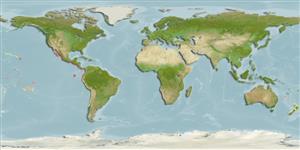Common names from other countries
Environment: milieu / climate zone / depth range / distribution range
Ecologia
marino demersale; distribuzione batimetrica 0 - 30 m (Ref. 5227). Tropical; 28°N -
Eastern Pacific: California, USA (Ref. 28023) to northern Chile, including the Galapagos Islands.
Size / Peso / Age
Maturity: Lm ? range ? - ? cm
Max length : 45.7 cm TL maschio/sesso non determinato; (Ref. 5592); common length : 30.4 cm TL maschio/sesso non determinato; (Ref. 5592)
Found in shallow water and seaweed-covered reefs as well as on open, sandy areas (Ref. 5592). An opportunistic predator, this cryptic fish lies unseen on the reef top waiting for small fishes to pass by (Ref. 5592). Although the flesh is of excellent quality, it is not utilized commercially due to its venomous spines (Ref. 9341).
Life cycle and mating behavior
Maturities | Riproduzione | Spawnings | Egg(s) | Fecundities | Larve
Grove, J.S. and R.J. Lavenberg, 1997. The fishes of the Galápagos Islands. Stanford University Press, Stanford, 863 p. (Ref. 28023)
IUCN Red List Status (Ref. 130435)
CITES (Ref. 128078)
Not Evaluated
Threat to humans
Traumatogenic (Ref. 28023)
Human uses
Pesca: pesca di sussistenza; Pesce da pesca sportiva: si
Strumenti
Special reports
Download XML
Fonti Internet
Estimates based on models
Preferred temperature (Ref.
115969): 20.6 - 29.1, mean 26.9 (based on 255 cells).
Phylogenetic diversity index (Ref.
82804): PD
50 = 0.5000 [Uniqueness, from 0.5 = low to 2.0 = high].
Bayesian length-weight: a=0.01318 (0.00626 - 0.02776), b=3.03 (2.86 - 3.20), in cm Total Length, based on LWR estimates for this Genus-body shape (Ref.
93245).
Trophic level (Ref.
69278): 3.9 ±0.2 se; based on size and trophs of closest relatives
Resilienza (Ref.
120179): Basso, tempo minimo di raddoppiamento della popolazione 4.5 - 14 anni (Preliminary K or Fecundity.).
Fishing Vulnerability (Ref.
59153): Moderate vulnerability (36 of 100).
